Wasted heat energy means wasted dollars. This is why effective heat management is of the upmost importance when manufacturing high-temperature applications. Ultimately, as temperatures and process requirements increase, so does the demand for insulation products which stand as the major solution to heat energy loss.
Several factors must be taken into into consideration when choosing an insulating system, including up-front investment, insulation efficiency, energy savings, productivity, lifetime, and health, safety and environment (HSE) compliance.1 Advancements in the insulation industry have led to the development of systems that use ceramic foam, such as Norfoam® by Saint-Gobain. Ceramic foam insulation provides solutions to the issues mentioned above, and thus is thought to be advantageous over conventional high-temperature insulating materials, such as insulating brick and ceramic fiber.
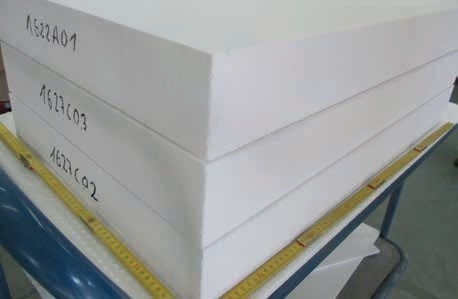
A patented direct foaming process is capable of producing board shapes with thicknesses of up to 150 mm, enabling simplified lining designs and efficient installations.
Insulating Refractory Brick
Refractory insulation brick, otherwise known as insulating firebrick (IFB), are traditionally used for the insulation of temperatures ranging from 1,260-1,840 °C. In general, the insulating performance of IFBs improves as the silica content of the brick increases. Unfortunately, this can negatively impact refractoriness, chemical inertness and mechanical strength of the brick, which in turn significantly restricts the use of the product in extreme environments. As insulating firebrick are machinable, any shape or design can be created using the appropriate tooling. However, because brick can be extremely abrasive towards machinery, this process is usually much more difficult than that of fiber-based products.
Refractory Ceramic Fiber
Refractory ceramic fiber (RCF), which provides effective thermal resistance, efficiency and shock resistance, has been used for insulation since the early 1950s. Unlike refractory brick, RCF is a fiber, and therefore can easily be manufactured to form any shape or design.
However, the use of RCFs for high-temperature insulation does have several limitations. For example, individual fibers tend to be mechanically weak and thus are sensitive to gas ablation. This results in fine fiber contamination that can impact downstream equipment as well as the finished product. Additionally, RCF material shrinks and crystallizes over time, producing degradation of thermal performance as the abutments of the installation widen and create thermal bridges. Finally, RCFs can be dangerous to humans and are carcinogenic under in some environments.2 The health risks associated with fibrous ceramic materials are in no doubt extremely serious and have led to strict regulations and restrictions of their use.
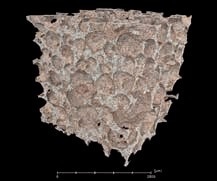
Figure 1. 3-D X-ray tomography of the ceramic foam.
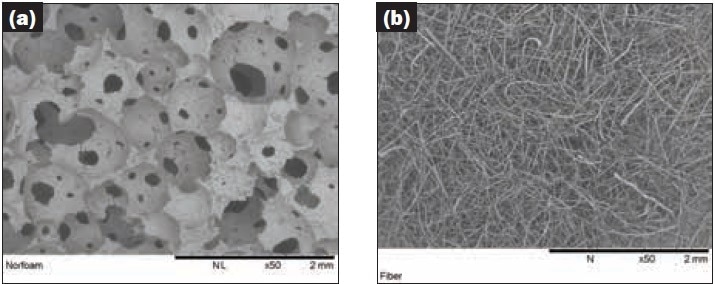
Figure 2. Microstructure of ceramic foam (a) and fiber (b).
In light of such concerns, new bio-soluble alkaline earth silicate (AES) fibers have been developed as an alternative to conventional RCF. However, it must be considered that their composition limits their use to temperatures below 1,250 °C.
New Ceramic Foam
Due to an increasing need for insulation that is high performing, readily formable and has low health risks, Saint-Gobain offer NorFoam® ceramic foams. These foams are HSE friendly and are available in a variety of compositions which are specifically designed to function reliably and effectively at temperatures exceeding 1,250 °C.
NorFoam’s patented foaming process permits ceramic insulation foam to be produced from many different materials, such as alumina, mullite, cordierite and zirconia. This can also be extended to non-oxide materials including silicon nitride and silicon carbide. Board shapes measuring thicknesses of up to 150 mm can be produced, allowing simplified lining designs and easy installations.
Due to its engineered microstructure and complex architecture, NorFoam offers advanced properties including outstanding machinability, insulating capability, thermal shock resistance, high purity, and alkaline and abrasion resistance, and stands as a potential alternative to traditional fibers such as refractory insulating brick and ceramic fiber.2
Fiber Free
Unlike refractory fibers, ceramic foam is 100 % fiber-free. This means that there is no risk of contamination from potentially dangerous fibers, and thus ceramic foam installations require no special equipment to protect workers, the workspace, or the environment. In particular, this applies to relining operations, whereby the ceramic fiber exists in an extremely weakened state making it very hazardous. Furthermore, ceramic foam products can be handled like brick, using mortar to join them, and do not need special disposal.
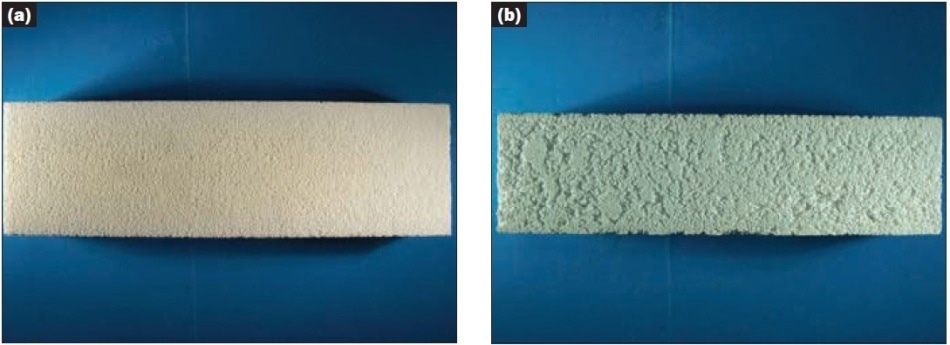
Figure 3. Ceramic foam finished edge (a) and traditional IFB finished edge (b).
Lighter Weight
Ceramic foam is light-weight and is available in larger dimensions. This makes it easier and faster to install in comparison to traditionally used IFB. Consequently, maintenance outages, relining or repairs can be completed at more rapid speeds, and are less physically demanding to install.
Safe for the Environment
The NorFoam process is based on a food-grade system and is constituted of high-purity mineral grains. This enables the foam to be recycled or disposed of like conventional waste with moderate disposal fees, compared to the high costs associated with fiber dumping. Ultimately, from the production process to end of life, ceramic foam impacts the environment less than conventional insulation materials.
Ease of Handling/Shaping
The ceramic foam is straightforward to manufacture and can be machined on-site with typical dry cutting tools or even a common wood saw. In contrast to fibers, cutting NorFoam does not release dangerous dust and hence does not require any use-restrictions. In addition, ceramic foam products can be machined with high precision. This produces very high-quality installation and further improves the furnace’s thermal efficiency.
Performance
Thermal conductivity and high temperature resistance are among the major stand-out features of importance when selecting a refractory insulation product. Ceramic foams combine the thermal capability of ceramic fiber with the strength and long-term performance of brick. Excellent thermal performance means the thermal mass and wasted heat of a furnace can be lowered, producing faster ram pups, improved temperature control, and reduced energy costs.
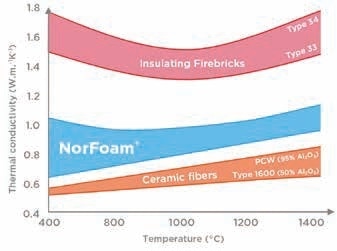
Figure 4. Comparative thermal conductivity of ceramic foams, IFB and type 184/400 fiber.

Ceramic foam lining in a nitrogen atmosphere furnace.
Adding Value
Ceramic foams are replacing traditional products in heat treatment and sintering furnaces as well as in metallurgy and glass applications. For example, NorFoam XPure has been shown to act as a better insulation system than mullite insulating brick in a furnace at 1,500 °C under pure nitrogen. Initially the furnace used the mullite insulating product, which reacted with alkaline released from the fired load and damaged the backup layer, producing unsafe hot spots on the furnace’s steel shell. However, once the hot face was replaced with ceramic foam, the furnace shell temperature declined and prevented any more damage.4
The low-mass inertia of the ceramic foam allows more efficient temperature control of the kiln and rapid heating/cooling ramps, providing a quantifiable productivity gain compared to conventional brick linings. Furthermore, less time is required for installation of ceramic foam than that of existing mullite solution. Overall, NorFoam actively lowers maintenance efforts, costs, and energy consumption, resulting in increasingly stable operations, higher planning and process availability, and positive energy management.
Ceramic foam products can be used as setters or spacers for firing a multitude of products due to their good mechanical strength and lightweight nature. Once in use, ramp rates are reported to increase, and reactor temperatures are said to be more stable, in addition to reported decreases in energy consumption. The innovative machinability of the ceramic foam, along with its mechanical strength, help to overcome critical design and operation problems with reactor parts.
Ceramic foam products are also thought to be majorly beneficial for applications within the metallurgy industry due to their strong resistance to molten metals. Typical reheating furnaces tend to be lined with insulating monolithics and fiber modules. However, such use is limited as scale dust, atmosphere impurities, and alkalis released from the burners can attack these linings and produce aging and early failure. Ceramic foams have intrinsic stable properties and prevent this premature wear. In particular, the petrochemical industry often requires high chemical inertness, high specific area and pore interconnection, meaning that ceramic foams are extremely attractive options for use in installations with catalytic reactions.
Summary
With advanced properties and limited operational, maintenance, and health and safety costs, ceramic insulating foams offer a solution for users looking to replace refractory fibers or refractory insulating brick, whether in present equipment or new installations. Among other assets, the excellent insulating performance, ease of use, and fiber-free nature of ceramic foam mean that use of this state-of-the-art material will only increase in coming years.
References
- “High Temperature Insulation Materials Market– Global Trends & Forecast to 2019,”
- Regulation EC 1272/2008.
- San-Miguel, L. and Schumann, M., “Fiber Free Ceramic Insulation Foam for Extreme Temperatures–A New Generation of HSE Friendly Refractory Products with Multiple Application Possibilities,” Refractories World Forum, August 2017 [2].
- Roulet, F.; San-Miguel, L.; and Schumann M., “Refractory Ceramic Foam–High Temperature Insulation Solution with Potential,” DKG Jahrestagung & Symposium Hochleistungskeramik, Freiberg, Germany, March 2016.

This information has been sourced, reviewed and adapted from materials provided by Saint-Gobain High-Performance Refractories.
For more information on this source, please visit Saint-Gobain High-Performance Refractories.